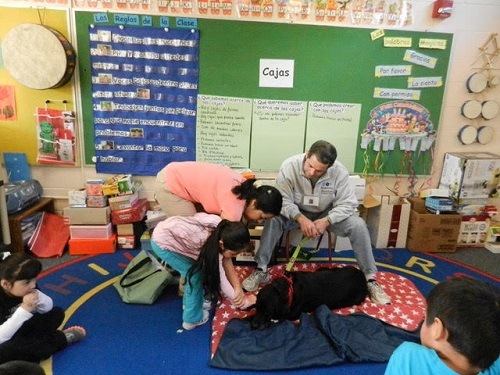Bringing a child into contact with a dog for the first time can be challenging, particularly if you’re a novice childcare provider or dog owner.
At K9 Reading Buddies, we know how important dogs feel safe and confident around children, particularly young ones.
Whether it’s your own child, a friend’s little one, or a child you’re meeting for other reasons, such as if you become a volunteer with us, you need to make sure you create a suitable space for everyone when introducing a child and dog.
That’s why we are keen to help dog owners everywhere create a safe and comfortable environment for kids and dogs alike.
So, if you’re planning on introducing your dog to children soon, then here are some practical tips to make things less stressful for you and your pup.
Think About The Personalities Involved
Before you start planning how you will introduce the dog and child, you should consider both parties’ personality traits.
For example, if the dog has spent a lot of time with children already and is patient and gentle, the process will be easier than if the dog has never met kids before and is skittish.
In addition to the dog’s disposition, it would help if you considered the child’s personality. If they have spent a lot of time with dogs and are calm, they will be better than a child who’s never met a dog before.
Their age is also a factor to consider. If the child is very young, they might pull the dog’s fur and not understand how to be gentle and quiet.
If they become noisy and upset, then the dog might get anxious. As a result, you should consider whether the child is old enough to meet your dog or if you will feel better waiting until they are older.
When you know all of this, you can make informed decisions about the environment in which you introduce your dog to the child.
Choose A Suitable Location
When introducing a child to your dog for the first time, the first consideration you should make is to find the right location for the meeting.
Consider finding a neutral ground such as a park or a location where both the child and the dog don’t live, such as a library or school classroom.
If the location is outside, try to find somewhere quiet so that there aren’t too many distractions for your dog and the child.
As obvious as it sounds, you should also ensure that the space is safe for children and dogs. That means that it shouldn’t have any exposed wires and be enclosed, so neither can leave without your knowledge and permission.
Carry A Supply Of Treats With You
Dogs are very food motivated, so if you are concerned about introducing your dog to children, you should ensure you have a supply of treats.
Even if you feel confident that your dog will be happy meeting children for the first time, you should still carry a selection of tasty snacks for your pet.
This approach will ensure that you can manage your dog with treats if they get distressed. It will also mean that you can use the treats to incentivize your dog exhibits good behavior during the meeting.
Tell The Child How To Approach Your Dog
Many children don’t know how to meet dogs, so before they approach your pup, you should tell them what they need to do.
Hand them a treat, and tell them to approach slowly.
The child should hold out their hand in a fist for the dog to sniff.
The child should then offer the treat with a flat hand to your dog.
If all has gone well, ask the child to move to your dog’s side to pet his back.
As the meeting begins, you should talk to the child and reassure them that they are doing the right things. If anything goes wrong, you need to make sure that you are close enough to deal with it without being too oppressive and sitting in between the two.
Tell the child what your dog’s “sweet spots” for petting are, for example, if they like scratches behind their ears, back massages, or belly rubs.
Only Unleash Your Dog When You’re Sure It Feels Safe
Initially, please keep your dog on a leash while she’s being introduced to the child. Once the dog feels more comfortable, you can consider letting the dog off the leash while being aware of her canine body language.
Once the dog is feeling comfortable and safe, you can let her off the leash. If the child is ten or over, you can allow the two to play while you are present.
If the child is very young, you should keep a close eye on your dog and the child to ensure that they are safe throughout the meeting.
Keep Introducing Them To Kids Under Supervision
Unless your dog is aggressive or overly distressed, you should consider introducing them to children several times under supervision to help them get used to spending time with young people.
This approach will help them to get used to being with kids and feel calmer in their presence. After some time, they should start to seem more relaxed and will need less supervision around children, although you should always keep an eye on them where possible.
Once your dog has improved and started to feel calmer around children, then you could consider signing them up to be a K9 Reading Buddy.
We have a range of programs for children of all ages and abilities, so you can find one that will suit your dog and help you give back to your community.
If you’re interested in finding out more about our programs and how you can help the children and us in your area, contact us. Our team will be happy to discuss our programs and the requirements we have from our four-legged volunteers.



